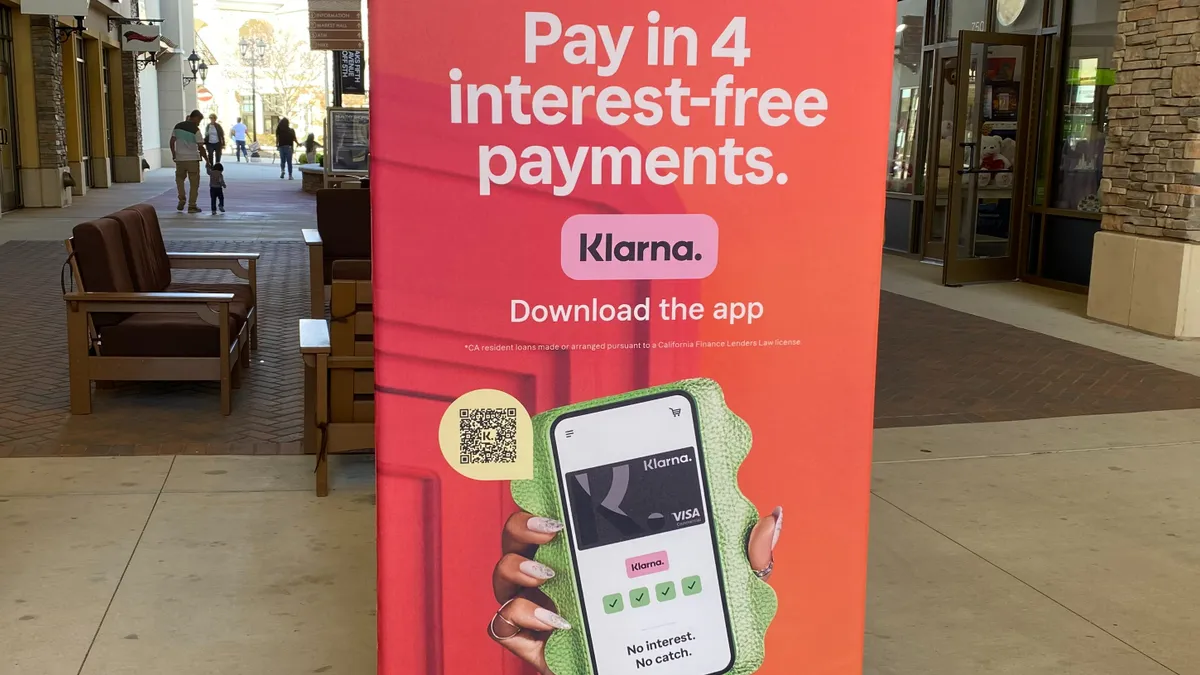Buy now, pay later provider Klarna may be preparing for an initial public offering, but the market likely wants to see the company deliver profits more consistently before it takes that leap, investors said.
Stockholm-based Klarna, which has amassed about 37 million U.S. users, is one of the bigger IPO candidates in the payments and fintech world. Still, the timing of its public debut has been ambiguous, said Rudy Yang, a senior research analyst focused on fintech at PitchBook. Other later-stage, privately-held startups expected to IPO include Stripe and Plaid.
Klarna CEO Sebastian Siemiatkowski has signaled that the company’s public offering of shares could occur “quite soon,” although the company hasn’t pinned down exactly when or where Klarna will IPO, Bloomberg reported.
Klarna is reported to be in talks with banks for a $20 billion U.S. IPO, potentially in the third quarter of this year, according to Bloomberg, which cited unnamed sources. Recently, the company has run into boardroom drama with one of its investors, venture capital firm Sequoia Capital, and reported tension between Siemiatkowski and Klarna co-founder Victor Jacobsson.
When contacted Tuesday, a Klarna spokesperson said no IPO “timing or location has been set,” and declined to comment.
Pursuit of profits
Although he couldn’t comment on Klarna’s specific situation, Chuckie Reddy, partner and head of growth investments at fintech-focused venture capital firm QED, said companies preparing for an IPO should have reached an appropriate amount of scale, and should have demonstrated profitability as well as the potential for further growth.
“You have to take the question marks out of the investors’ minds,” Reddy said. “You used to just sell a story and a bit of a hope that things will materialize. I think, now, you need to be more in the proof camp rather than in the hope camp.”
Klarna recorded a profit in the third quarter of last year, of 130 million Swedish kronor, or about $12.7 million, but the company reported a loss of about 2.5 billion Swedish kronor, or about $244 million, for the entirety of 2023. The BNPL provider, continuing “on our journey to long-term profitability,” made a “conscious decision” to invest in growth in the fourth quarter, Siemiatkowski said in an earnings news release last month.
Before a filing with the Securities and Exchange Commission for an offering, typically by way of an S-1 form, “the company will have wanted to be solidly profitable for a period of time,” Reddy said. “You're going to want some amount of track record, so when your S-1 prints, you actually can show a demonstrated track record of profitability.”
Klarna’s move in January to add a subscription service was a signal to analysts and consultants that the company seeks to diversify revenue streams in the run-up to an IPO. For Klarna, evaluating propensity for growth is important, given the ebbs and flows the BNPL industry has experienced in recent years, said Sheridan Trent, director of market intelligence at payments consulting firm TSG.
Because the company operates on the global stage, offering it an opportunity to further scale, there’s likely investor appetite for Klarna’s IPO, said Drew Glover, partner at fintech-focused venture capital firm Fiat Ventures.
Glover’s unsure, however, whether Klarna will be able to snag the valuation the company may envision, partly because investor interest has waned in BNPL business models and consumer-focused fintech.
Late last year, Moody’s Investors Service analysts warned that fierce competition, potential regulation, economic constraints and persistent losses all make for a dire outlook for BNPL companies. “I would expect that if they do launch an IPO, they expect it to be well received,” Niclas Boheman, vice president and senior credit officer at Moody’s, said about Klarna, in an email. “It’s an intensive and expensive process, so you don’t want to fail.”
Gauging timing
To that end, Reddy expects a company like Klarna is closely watching other public debuts, and waiting until the market is in a period of calm. Investment bankers help companies assess relative market sentiment, although the process is “a bit of an art, not a science” when it comes to timing, he said.
Potential Federal Reserve rate cuts and U.S. election volatility may also influence the timing of IPOs, Reddy noted. Companies are “in the mode where you’ve got to hurry up and wait, get ready, be ready to hit the market when the market is in a good spot,” he said.
The latter half of the year could be more likely for Klarna’s IPO than the second quarter, said Autonomous Research Analyst Rob Wildhack. Klarna has “made a lot of progress internally,” with pushes to improve profitability and expand into shopping and AI tools, he said.
Externally, Klarna probably wants to see other IPOs do well and peers trading at an attractive comparable valuation, Wildhack added.
Klarna is likely tracking how BNPL rival Affirm is traded, analysts and investors said. “If Affirm is out of favor, then it’s probably not the best time to put your debut out there,” Reddy said.
Ultimately, most companies aren’t looking to rush things if they won’t get the returns they’ve envisioned, and investors aren’t pressing them to do so.
Reddy said companies in QED’s portfolio planning a public debut have pushed their targeted timing out an additional year. “Giving these companies a little more time seems like a good insurance policy,” he said.


















